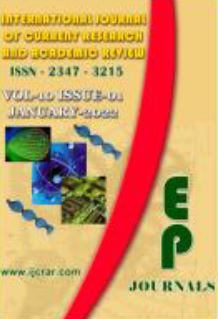Abstract Volume:10 Issue-1 Year-2022 Original Research Articles
 |
Online ISSN : 2347 - 3215 Issues : 12 per year Publisher : Excellent Publishers Email : editorijcret@gmail.com |
Ethiopian Institute of Agricultural Research (EIAR), Fogera National Rice Research and Training Centre, Bahir Dar, Ethiopia
Land cover refers to the surface cover on the ground, whether vegetation, urban, water, bare soil or other. It is important for monitoring studies, resource management, and planning activities. Remote sensing has become an important tool applicable to developing and understanding the global, physical processes affecting the land surface. Total cultivated land, production, and productivity of rice have been significantly increased within the period of the two decades and still, it is increasing. Different data source and researcher have different figures about the land use and the area coverage of the district by rice. It shows that the trend of rice expansion, currents status and land coverage area of rice not well documented. This study aimed to detect land use land cover change and rice explanation over Fogera district using remote sensing approach. In this study, we intended to apply a long-term LULC analysis in a rural region based on a Landsat time series. In this study, we intended to apply a long-term LULC analysis in a rural region based on a Landsat 7 time series of 7 years (2013 to 2019). Here, we were investigated the use of open LULC source data to provide training samples and the application of supervised classification technique to refine the broad range of spectral signatures for each LULC class. The rate of rice explanation was assessed with three years’ interval and the performance of remote sensing approach was checked the performance indicators like Producer Accuracy (%), Omission Error (%) User Accuracy (%), Commission Error (%), Overall Accuracy (%) and Kappa Coefficient (%) with the observed grand data. Landsat TM for the date December 1994 and Landsat ETM+ for the date October 2013,2016 and 2019 which have 30m, resolution was acquired. WGS_1984_UTM_Zone_37N projection was used to georeferenced and to geo rectify the images. Satellite images were classified by supervised classification through maximum likelihood classifier algorithm on GIS 10.4 and ERDAS Imagine 14. The negative value indicates that the land use land cover for forest decreases from 2013 to 2016and for other land uses the positive value indicates the increment from year to year. But our area of interest was detecting the change and trend of rice crop in Fogera plain. The land use and coved by rice crop in Fogera district in 2013, 2016 and 2019 was 17118.45 ha, 12376.44 ha and 17295.57 ha respectively. The change in detection of rice was decreasing from the base line (2013) to 2016 by 27.7% this may be due to high flood season. Whereas increases from 2016 to 2019 by 39.75%.
How to cite this article:
Belachew Muche Mekonen. 2022. Assess the Trends of Rice Expansion in Fogera District, using GIS and Remote Sensing Approach.Int.J.Curr.Res.Aca.Rev. 10(1): 18-33doi: https://doi.org/10.20546/ijcrar.2022.1001.003



Quick Navigation
- Print Article
- Full Text PDF
- How to Cite this Article
- on Google
- on Google Scholor
- Citation Alert By Google Scholar
